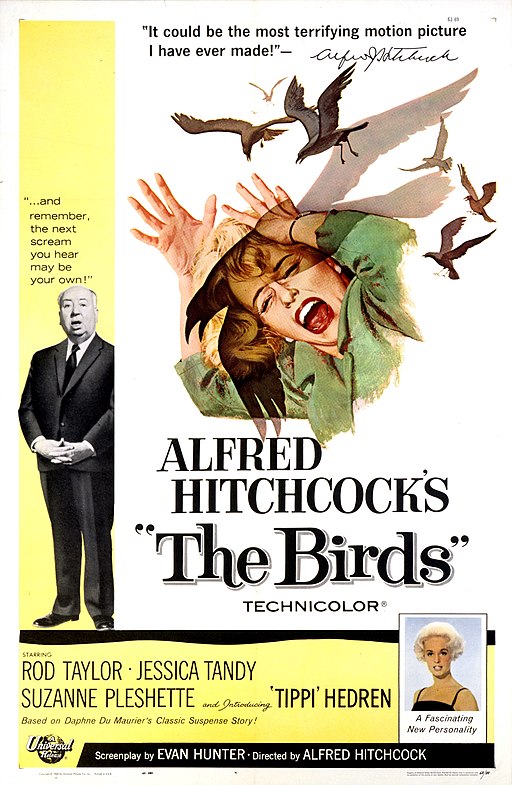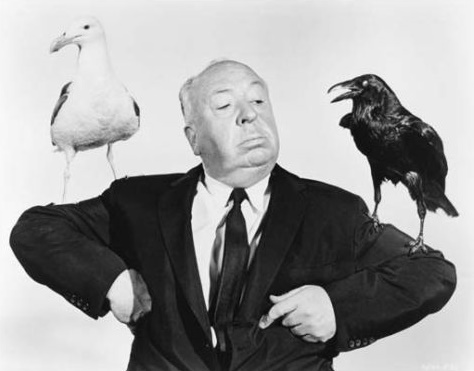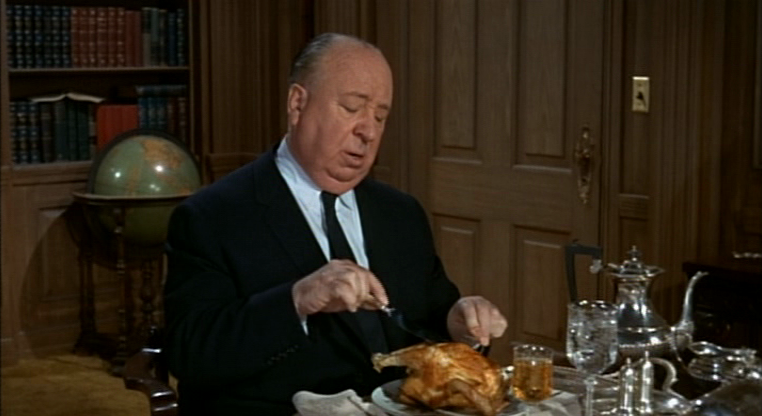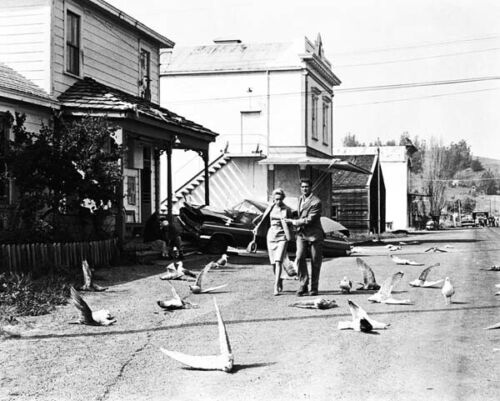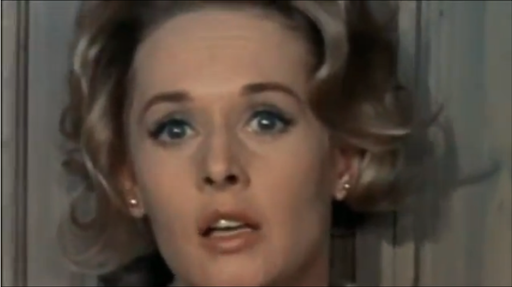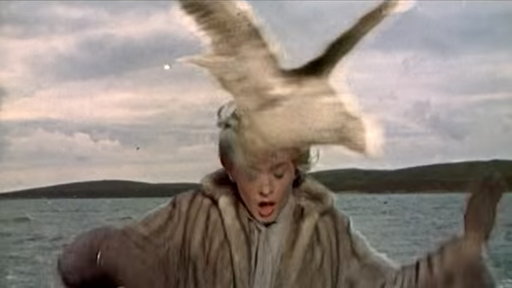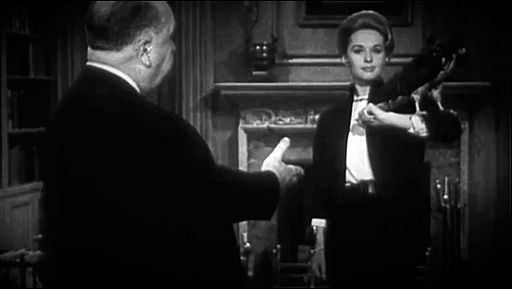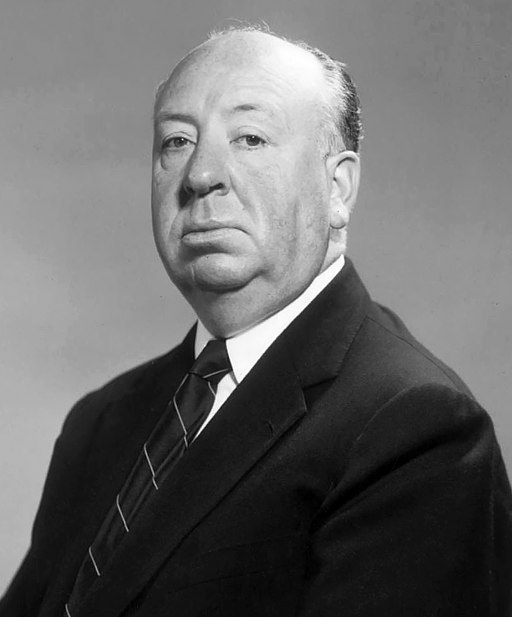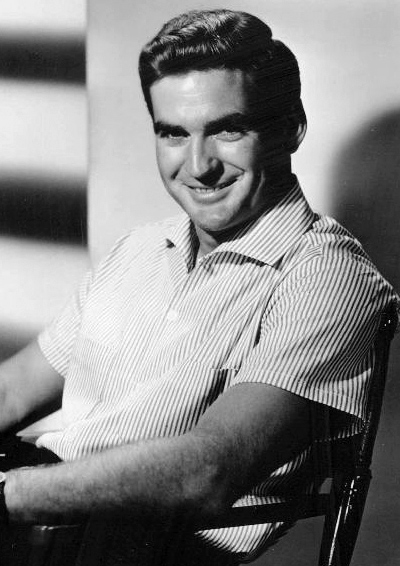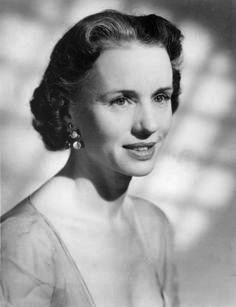The Birds - 1963
back| Released by | Universal Pictures |
| Director | Alfred Hitchcock |
| Producer | Alfred Hitchcock |
| Script | Evan Hunter, based on a story by Daphne du Maurier |
| Cinematography | Robert Burks |
| Music by | Oskar Sala and Remi Gassmann (electronic sound production) |
| Running time | 119 minutes |
| Film budget | $2.5 million |
| Box office sales | $11.4 million in the United States |
| Main cast | Tippi Hedren - Rod Taylor - Jessica Tandy - Suzanne Pleshette - Veronica Cartwright |
The Birds
Unnerving orchestration of suspense
Alfred Hitchcock's "The Birds" (1963) is a groundbreaking horror-thriller that revolves around unexplained, violent bird attacks in a small California town.
Tippi Hedren stars as Melanie Daniels, a socialite who becomes embroiled in the chaos. The film is marked by its lack of conventional soundtrack, instead using innovative sound effects to heighten tension.
Its narrative, blending psychological depth with horror elements, builds an atmosphere of suspense and fear. "The Birds" is a cinematic milestone, notable for its pioneering special effects and Hitchcock's masterful tension-building. Its ambiguous ending and exploration of nature's unpredictability have influenced not only the horror genre but also the broader landscape of filmmaking, leaving a lasting imprint on cinematic storytelling techniques and audience expectations.
Related
The Birds - 1963
Summary and Analysis of Direction and Acting
"The Birds," directed by Alfred Hitchcock, is a 1963 horror-thriller film that has gained iconic status over the years.
Summary
Setting: The film is set in Bodega Bay, a small coastal town in California.
Plot Overview:
- Beginning: The story begins in a San Francisco bird shop, where a playful socialite, Melanie Daniels, meets a lawyer, Mitch Brenner. Mitch is looking to buy lovebirds for his sister's birthday. Intrigued by him, Melanie decides to deliver the birds to his home in Bodega Bay.
- Middle: Upon arriving in Bodega Bay, Melanie forms relationships with various townspeople, including Mitch’s mother Lydia and his ex-girlfriend Annie. Soon, the town experiences bizarre incidents of birds attacking humans. The attacks grow increasingly violent and frequent.
- Climax: The most dramatic attack occurs at Cathy’s birthday party, and later, a large flock of birds assaults the Brenners' home.
- Ending: The film concludes ambiguously, with Melanie, the Brenners, and the lovebirds leaving the house cautiously, surrounded by a sea of quietly perched birds, driving slowly through the town, which is now eerily overrun by birds.
Analysis
Themes:
- Nature vs. Humanity: The film explores the unpredictable and often terrifying elements of nature, suggesting that humans are not always in control.
- Fear of the Unknown: The birds' inexplicable behavior creates a sense of dread and suspense, reflecting fears of unexplained phenomena.
- Interpersonal Relationships: The complex dynamics between Melanie, Mitch, Lydia, and Annie provide a human context to the bizarre events, exploring themes of love, jealousy, and familial bonds.
Technical and Artistic Elements:
- Suspense Building: Hitchcock masterfully builds suspense, using the unpredictability and suddenness of the bird attacks.
- Sound Design: The film is notable for its innovative use of sound and lack of conventional musical score, relying on electronically created bird sounds to heighten tension.
- Cinematography and Special Effects: Hitchcock's use of practical effects (trained birds and mechanical devices) and innovative camera techniques was groundbreaking for its time.
Symbolism:
- Birds as Symbols: The birds could be interpreted as symbols of chaos, nature's unpredictability, or even deeper psychological fears and tensions within the characters.
- Cage Imagery: The use of birds, often caged, contrasts with the theme of entrapment and freedom, both in terms of the physical attacks and the interpersonal relationships of the characters.
Legacy and Impact:
- The film is considered a masterpiece in suspense and horror.
- It influenced many subsequent films in terms of both thematic content and technical innovation in film-making.
- The ambiguous ending was particularly notable, leaving audiences unsettled and sparking much discussion and interpretation.
Full Cast of “The Birds”:
- Tippi Hedren as Melanie Daniels
- Rod Taylor as Mitch Brenner
- Jessica Tandy as Lydia Brenner
- Suzanne Pleshette as Annie Hayworth
- Veronica Cartwright as Cathy Brenner
- Ethel Griffies as Mrs. Bundy, the ornithologist
- Charles McGraw as Sebastian Sholes, a fisherman
- Ruth McDevitt as Mrs. MacGruder, the bird shop owner
- Joe Mantell as Traveling Salesman at Diner's Bar
- Karl Swenson as Drunken Doomsayer in Diner
- Richard Deacon as Mitch's City Neighbor
- Doodles Weaver as Fisherman helping with Rental Boat
- Malcolm Atterbury as Deputy Al Malone
- John McGovern as Postal Clerk
- Lonny Chapman as Diner Owner
- Joe Payne as Diner Patron
- Doreen Lang as Hysterical Mother in Diner
- Morgan Brittany (credited as Suzanne Cupito) as Brunette Girl in Diner
- Bill Quinn as Sam - Man in Diner
- Elizabeth Wilson as Helen Carter, Deke's Mother
- Darlene Conley as Waitress at Diner
- C. Ransom Walrod as Customer at Diner
Analysis of Alfred Hitchcock’s Direction:
Alfred Hitchcock's direction in "The Birds" (1963) showcases his masterful command of suspense, innovative use of technology, and psychological insight. Here's an analysis of his direction in this film:
Mastery of Suspense
- Building Tension: Hitchcock was known as the "Master of Suspense," and in "The Birds," he skillfully builds tension not through action but anticipation. The audience is kept on edge, never knowing when the next attack will occur. This unpredictability creates a pervasive sense of dread.
- Foreshadowing: He uses subtle foreshadowing to heighten the suspense. The film starts with a minor bird incident and escalates steadily, keeping viewers in a constant state of unease.
Innovative Use of Technology
- Special Effects: Hitchcock pushed the boundaries of available technology. He mixed live birds with mechanical ones and used innovative techniques for the bird attack scenes. These sequences required meticulous planning and execution.
- Sound Design: Perhaps one of the most notable aspects is the absence of a traditional musical score. Instead, Hitchcock used a mixture of bird sounds and electronic sounds created by Remi Gassmann and Oskar Sala, using the Trautonium, an early electronic instrument. This choice made the bird attacks more jarring and unsettling.
Psychological Depth
- Character Development: Hitchcock's characters in "The Birds" are complex and multi-dimensional. He explores themes like maternal anxiety, romantic tension, and societal roles. These human elements provide a stark contrast to the chaotic bird attacks.
- Symbolism: The birds themselves can be interpreted as symbols of chaos and uncontrolled natural forces. Some critics have suggested that they also represent deeper psychological fears, perhaps stemming from the characters' emotional conflicts.
Visual Storytelling
- Cinematography: Hitchcock's use of cinematography is deliberate and purposeful. He uses tight shots to create a sense of confinement and wider shots to emphasize the vastness and isolation of the setting.
- Camera Angles: The director's choice of camera angles often aligns with the characters’ perspectives, immersing the audience in their experience, especially during the attack scenes.
Handling of Themes
- Nature vs. Humanity: Hitchcock explores the theme of nature’s unpredictability and power over humanity. The film challenges the notion of humans as the dominant force in nature.
- Ambiguity: Hitchcock leaves many questions unanswered, including the reason behind the birds' attacks. This ambiguity adds to the film's unsettling nature and leaves room for various interpretations.
Legacy
- "The Birds" is a testament to Hitchcock's ability to innovate within the constraints of the time and to explore new ways of storytelling. The film's influence is seen in many subsequent horror and thriller films, particularly in how tension and fear can be generated without graphic visuals or a conventional soundtrack.
In summary, Hitchcock's direction in "The Birds" is a blend of technical innovation, psychological insight, and suspenseful storytelling. It underscores his status as a visionary filmmaker, capable of turning a simple, even absurd premise, into a deeply unsettling and enduring cinematic experience.
Official Trailer of "The Birds"
Here you can watch the 1963 official trailer of "The Birds":
Analysis of Tippi Hedren’s Performance:
Tippi Hedren's portrayal of Melanie Daniels in Alfred Hitchcock's "The Birds" is a pivotal element of the film, offering depth and complexity to both the character and the narrative.
Character Traits and Development
- Initial Portrayal: Melanie Daniels is introduced as a glamorous, wealthy socialite from San Francisco. She's playful, somewhat flirtatious, and displays a sense of independence and assertiveness, particularly in her initial interactions with Mitch Brenner.
- Transformation: As the film progresses, Melanie’s character undergoes a significant transformation. The bird attacks force her to move from a carefree, somewhat superficial character to a more serious, protective, and empathetic figure, especially concerning the Brenner family.
Performance and Interpretation
- Subtlety and Complexity: Hedren's performance is noted for its subtlety and complexity. She conveys a range of emotions, from the initial light-heartedness to terror, vulnerability, and strength, often with minimal dialogue.
- Physical Acting: Much of Hedren's performance is physical, particularly in scenes of chaos and terror during the bird attacks. Her expressions and reactions contribute significantly to the film's suspense.
Interaction with Other Characters
- Relationship Dynamics: Melanie’s interactions with other characters, such as Mitch Brenner, his mother Lydia, and his ex-girlfriend Annie, are central to the film. These interactions reveal different facets of her personality, including her capability for jealousy, compassion, and ultimately, heroism.
- Maternal Instincts: Her relationship with Mitch’s younger sister, Cathy, brings out a maternal side in Melanie, contrasting with the more complicated maternal figure of Lydia Brenner.
Symbolism and Themes
- Melanie as a Catalyst: Some interpretations suggest that Melanie’s arrival in Bodega Bay acts as a catalyst for the bird attacks, though this is never explicitly stated. Her presence disturbs the town’s equilibrium, mirroring the disruption caused by the birds.
- Empowerment and Vulnerability: Melanie represents a modern, independent woman who is both empowered and vulnerable. Her experiences in the film reflect broader themes of human vulnerability in the face of nature’s unpredictable power.
Impact of the Role
- Iconic Status: Hedren’s role as Melanie Daniels has become iconic in the history of cinema, particularly in the thriller and horror genres.
- Challenges and Controversies: The role was physically and emotionally demanding, with Hedren enduring real-life bird attacks during filming, which added a layer of authenticity to her performance but also raised questions about actor safety and directorial ethics.
Memorable Quotes from “The Birds”:
Melanie Daniels (Tippi Hedren):
"I think you're the cause of all of this. I think you're evil. EVIL!"
- This line reflects the growing tension and fear among the townspeople as they grapple with the inexplicable bird attacks.
Mrs. Bundy, the ornithologist (Ethel Griffies):
"Birds have been on this planet, Miss Daniels, since Archaeopteryx, a hundred and forty million years ago. Doesn't it seem odd that they'd wait all that time to start a war against humanity."
- This quote, delivered by the ornithologist in the film, adds a scientific perspective to the bizarre events and highlights the absurdity of the situation.
Lydia Brenner (Jessica Tandy):
"I wish I were stronger. I don't want to be afraid of life or anything else."
- Lydia's words reflect her inner turmoil and the general sense of vulnerability that permeates the film.
Mitch Brenner (Rod Taylor) to Melanie:
"Don't you remember one thing about the law, it's that everything is negotiable."
- This line, spoken by Mitch, can be seen as a metaphor for the unpredictability of the situation in which the characters find themselves.
Melanie Daniels:
"I hardly think a few birds are going to bring about the end of the world."
- Said in the earlier part of the film, this line becomes ironic as the bird attacks intensify, highlighting the theme of humans underestimating nature.
Annie Hayworth (Suzanne Pleshette) to Melanie:
"Mitch has always said that you can't be possessed by a few birds and, well, I think you're hurting Cathy. What's the matter with you?"
- This quote speaks to the growing concern and confusion among the characters about Melanie's role in the strange events.
Sebastian Sholes, fisherman (Charles McGraw):
"These are gulls, crows, swifts..."
- This line, part of a larger conversation among townspeople, emphasizes the bizarre nature of different bird species uniting in their aggression towards humans.
Movie Location:
"The Birds," directed by Alfred Hitchcock, was primarily filmed in and around Bodega Bay, California, which is a small coastal town located about 60 miles north of San Francisco. This location was central to the film’s eerie and isolated atmosphere. Here are some key details about the movie's locations:
- Bodega Bay: The bulk of the outdoor scenes were shot in Bodega Bay. The town's coastal setting, with its expansive views of the Pacific Ocean and its quaint, small-town feel, added a crucial element of believability to the story. The isolation of the town played into the film's themes of unexplained natural phenomena and human vulnerability.
- The Potter Schoolhouse: One of the most iconic scenes in the movie, where children are attacked by birds as they leave school, was filmed at the Potter Schoolhouse in Bodega (not Bodega Bay). This historic building has since become a popular tourist attraction because of the film.
- The Tides Wharf & Restaurant: Many scenes, including those featuring the town's diner and a dock, were filmed at The Tides Wharf in Bodega Bay, which at the time was a local restaurant and inn. It has since been rebuilt and remains a popular spot for both locals and tourists.
- San Francisco: The opening scenes of the film were shot in San Francisco, particularly the scene in the pet store, which establishes the initial meeting of the two main characters, Melanie Daniels (Tippi Hedren) and Mitch Brenner (Rod Taylor).
- Studio Filming: For some of the more complex bird attack scenes, including the climactic attack on the Brenner home, the filming was done in a studio using a combination of live birds, mechanical birds, and elaborate set pieces to create the realistic and terrifying bird attacks.
Analysis of the Performance of Jessica Tandy as Mrs. Brenner:
Jessica Tandy's portrayal of Lydia Brenner in Alfred Hitchcock's "The Birds" is a key component of the film, providing depth to both the narrative and the thematic exploration of human relationships and fears. Here's an analysis of her role:
Character Traits and Development
- Initial Portrayal: Lydia Brenner is initially presented as a strong, somewhat overbearing mother to Mitch Brenner. She displays a sense of protectiveness and possessiveness over her son, which borders on controlling.
- Vulnerability and Fear: As the story unfolds, Lydia's character reveals layers of vulnerability and fear. After the death of a neighbor and the escalating bird attacks, her facade of strength begins to crumble, exposing a more fragile, anxious side.
Performance and Interpretation
- Complex Emotions: Tandy's performance is nuanced, capturing the complexity of a mother struggling with the fear of losing her son to another woman (Melanie) and the terror brought by the bird attacks.
- Expression of Fear: Tandy effectively portrays a woman grappling with her own fears, which are not only related to the birds but also to the changes and challenges within her family dynamics.
Interaction with Other Characters
- Dynamic with Melanie: Lydia's relationship with Melanie Daniels (Tippi Hedren) is central to the film. Initially, Lydia is wary and somewhat hostile towards Melanie, viewing her as a threat to her relationship with her son. However, as the film progresses, Lydia’s attitude softens, showing a reluctant acceptance and even dependence on Melanie.
- Maternal Concern: Lydia's interactions with her children, Mitch and Cathy, show her deep maternal concern, which becomes more pronounced as the situation with the birds escalates.
Symbolism and Themes
- Maternal Instincts: Lydia's character embodies the theme of maternal instincts and the fears associated with motherhood, including the fear of abandonment and loss.
- Contrast with Melanie: Lydia’s initial coldness towards Melanie can be seen as a contrast between traditional and modern views of womanhood and motherhood, with Lydia representing the former and Melanie the latter.
Impact of the Role
- Depth to Narrative: Jessica Tandy's portrayal adds significant depth to the narrative, grounding the fantastical elements of the story with a profoundly human, relatable character.
- Psychological Complexity: Her performance contributes to the psychological complexity of the film, intertwining personal fears with the overarching terror of the bird attacks.
Teaser Trailer spoken by Alfred Hitchcock
Just before the release of the movie Alfred Hitchcock made a special teaser for promoting the film. Of course he did it in his own unique and humorous style:
Music Score in “The Birds”:
"The Birds," directed by Alfred Hitchcock, is notable for its absence of a conventional music score, which was a highly unconventional choice for a film at the time, especially for a suspense or horror film. Instead of traditional music, the film utilizes a combination of natural bird sounds and innovative electronic sound effects to create the mood and heighten the tension. Here are some key aspects of the film's sound design:
- Electronic Sound Production: The film's sound track is largely the work of Oskar Sala and Remi Gassmann, who used an electronic instrument called the Trautonium to create the eerie and unsettling sounds that mimic bird noises and ambient sounds. The Trautonium, an early electronic musical instrument invented in the 1920s, was capable of producing a wide range of sounds, from the mimicking of natural bird calls to more abstract and dissonant noises.
- No Conventional Score: Hitchcock’s decision to forego a traditional musical score was revolutionary. Instead of guiding the audience’s emotions with music, he chose to let the sounds of the birds themselves, both natural and electronically modified, set the tone. This approach creates a more realistic and immersive atmosphere, making the bird attacks feel more sudden and jarring.
- Sound as a Tool for Suspense: The use of sound in "The Birds" is integral to its suspense. The silences and sudden bursts of sound contribute to the film's unsettling nature. The unpredictability of the sound design parallels the unpredictability of the birds' behavior.
- Psychological Impact: The unique sound design contributes to the film's psychological impact. The absence of music leaves viewers more exposed to the rawness of the scenes, making the bird attacks more intense and the quiet moments more unnerving.
- Legacy: The sound design of "The Birds" was groundbreaking and has influenced how sound and silence are used in film, particularly in the horror and thriller genres. It demonstrated how sound could be used creatively to enhance the storytelling and emotional impact of a film.
Silver Car in The Birds:
In Alfred Hitchcock's "The Birds," the silver sports car driven by Tippi Hedren's character, Melanie Daniels, is a notable element of the film. The car is an Aston Martin DB2/4. Here are some details about it:
- Model and Make: The car is an Aston Martin DB2/4, a British sports car produced by Aston Martin. This model was known for its luxury and performance, fitting the profile of Melanie Daniels, a wealthy and sophisticated socialite.
- Symbolic Representation: The car adds to Melanie's character portrayal, emphasizing her stylish, affluent, and independent persona. It reflects her glamorous lifestyle in contrast to the small, rural town of Bodega Bay.
- Cinematic Impact: Visually, the silver color of the car stands out in the film's often-muted color palette, drawing attention to Melanie's character and her outsider status in the small community of Bodega Bay.
- The Aston Martin DB2/4: This model was produced between 1953 and 1957. It was well-regarded for its elegance and was one of the first hatchbacks, combining sports car performance with some level of practicality. The DB2/4 was a significant evolution from the earlier DB2 model, offering increased power and improved styling.
- Screen Presence: The car's appearances in the film are memorable, especially its arrival in Bodega Bay, which marks the beginning of Melanie's adventurous endeavor and sets the stage for the unfolding of the film's events.
The use of a luxury sports car like the Aston Martin DB2/4 in "The Birds" was a deliberate choice by Hitchcock to help define Melanie's character. It provided a visual cue to her cosmopolitan nature and set her apart from the other characters, reinforcing the themes of intrusion and otherness that are prevalent in the film.
Awards and nominations:
Academy Awards (Oscars):
- 1964 Nomination: The film was nominated for an Oscar for Best Effects, Special Visual Effects. This nomination recognized the groundbreaking work done in the film's visual effects, particularly the bird attack scenes.
Golden Globe Awards:
- 1964: Tippi Hedren won the Golden Globe for New Star of the Year – Actress. This award recognized her breakout performance in "The Birds," which was her debut film role.
Satellite Awards:
- In later years, the film was nominated for the Satellite Award for Outstanding Classic DVD. This nomination was for the film's DVD release and not for the original film production.
"The Birds" is more recognized for its artistic and technical achievements, particularly in the area of special effects, and for Hitchcock's innovative directorial techniques. Its influence extends beyond the scope of traditional awards, having a lasting impact on the thriller and horror genres in cinema. Despite the relatively limited number of awards and nominations, the film remains a critical piece of cinematic history.

